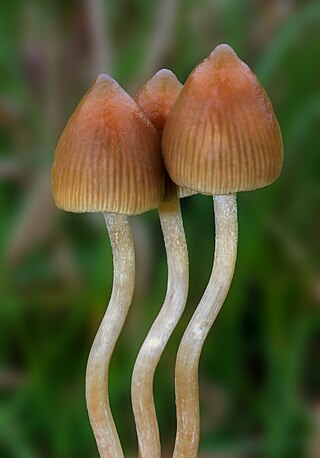
Psilocybe semilanceata, commonly known as the liberty cap, is a species of fungus which produces the psychoactive compounds psilocybin, psilocin and baeocystin. It is both one of the most widely distributed psilocybin mushrooms in nature, and one of the most potent. The mushrooms have a distinctive conical to bell-shaped cap, up to 2.5 cm (1 in) in diameter, with a small nipple-like protrusion on the top. They are yellow to brown, covered with radial grooves when moist, and fade to a lighter color as they mature. Their stipes tend to be slender and long, and the same color or slightly lighter than the cap. The gill attachment to the stipe is adnexed, and they are initially cream-colored before tinting purple to black as the spores mature. The spores are dark purplish-brown in mass, ellipsoid in shape, and measure 10.5–15 by 6.5–8.5 micrometres.

Psilocybe mexicana is a psychedelic mushroom. Its first known usage was by the natives of North and Central America over 2,000 years ago. Known to the Aztecs as teotlnanácatl, from the Nahuatl teotl ("god") + nanácatl ("fungus"). This species was categorized by French botanist Roger Heim.

Psilocybe azurescens is a species of psychedelic mushroom whose main active compounds are psilocybin and psilocin. It is among the most potent of the tryptamine-bearing mushrooms, containing up to 1.8% psilocybin, 0.5% psilocin, and 0.4% baeocystin by dry weight, averaging to about 1.1% psilocybin and 0.15% psilocin. It belongs to the family Hymenogastraceae in the order Agaricales.
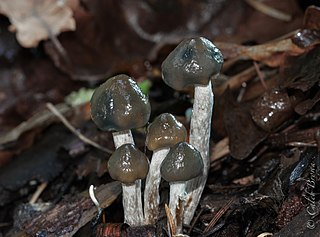
Psilocybe baeocystis is a psilocybin mushroom of the family Hymenogastraceae. It contains the hallucinogenic compounds psilocybin, psilocin and baeocystin. The species is commonly known by various names such as bottle caps, knobby tops, blue bells, olive caps.

Psilocybe ovoideocystidiata is a psilocybin mushroom, having psilocybin and/or psilocin as main active compounds. It is closely related to P. subaeruginascens from Java, P. septentrionalis from Japan, and P. wayanadensis from India. This mushroom was first documented by Richard V. Gaines in Montgomery County, Pennsylvania in June 2003. Although it is sometimes confused with Psilocybe caerulipes, it can be distinguished by its rhomboid spores, larger stature, earlier fruiting season and membranous annulus.

Psilocybe caerulipes, commonly known as blue-foot, is a rare psilocybin mushroom of the family Hymenogastraceae, having psilocybin and psilocin as main active compounds. An older synonym is Agaricus caerulipes.

Psilocybe zapotecorum is a psilocybin mushroom which has psilocybin and psilocin as main active compounds. It is in the section Zapotecorum.
Psilocybe subaeruginascens is a psychedelic mushroom which has psilocybin and psilocin as main active compounds. This mushroom is closely related to Psilocybe ovoideocystidiata.
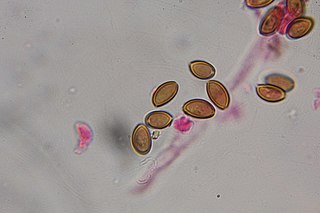
Psilocybe strictipes is a mushroom that grows on grassy meadows and lawns; It is found throughout the cool temperate and subarctic regions of the Northern Hemisphere and it is most common in Europe, and the Pacific Northwest region of North America. It contains the psychoactive compound psilocybin is closely related to Psilocybe semilanceata and Psilocybe pelliculosa. Psilocybe strictipes is commonly confused with Psilocybe semilanceata and can be differentiated by its lack of a papilla and a convex to subumbonate cap. "Strictipes" comes from the Latin words stricti (narrow) and pes (foot).
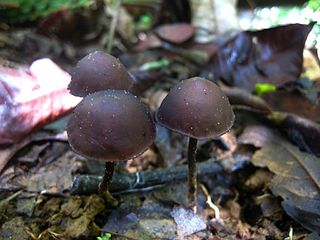
Psilocybe guilartensis is a psilocybin mushroom which has psilocybin and psilocin as main active compounds. It is common in Puerto Rico.
Psilocybe galindoi is a psychedelic mushroom in the section Mexicana, having psilocybin and psilocin as its main active compounds. It is also known as Psilocybe galindii. The species was named in honor of Mr. Carlos Galindo Arias and his family by Dr. Gastón Guzmán.
Psilocybe graveolens is an extremely rare psilocybin mushroom which has psilocybin and psilocin as main active compounds, discovered in the salt marshes or "meadows" of Hackensack, New Jersey. This mushroom is known for its strong and persistent odor.

Psilocybe caerulescens, also known as landslide mushroom, is a psilocybin mushroom having psilocybin and psilocin as main active compounds. Along with Psilocybe mexicana and Psilocybe aztecorum, it is one of the mushrooms likely to have been used by the Aztecs and is currently used by Mazatec shamans for its entheogenic properties.

Psilocybe mescaleroensis is a psychedelic mushroom which has psilocybin and psilocin as main active compounds. This mushroom is closely related to Psilocybe hopii and Psilocybe cyanescens. It was brought to scientific attention by Lee Walstad.

Psilocybe cyanofibrillosa, also known as rhododendron psilocybe and blue-haired psilocybe, is a psilocybin mushroom of the family Hymenogastraceae having psilocybin and psilocin as main active compounds. First documented in 1980 in the Pacific Northwest, it is relatively uncommon and can be distinguished from other closely related species by its smaller spores and forking cheilocystidia. Psilocybe cyanescens also has forking cheilocystidia, but less often than Psilocybe cyanofibrillosa. Psilocybe cyanofibrillosa is also distinguished from Psilocybe cyanescens by an absence of pleurocystidia. The name of this species refers to the fibrils on the Stipe (mycology) that turn bluish in age, or when handled.

Psilocybe samuiensis is a psychedelic mushroom, which has psilocybin and psilocin as main active compounds. It was placed in the section Mexicanae of genus Psilocybe by Gastón Guzmán due to its rhomboid-shaped spores. It has been found in Koh Samui, a small tropical island in Thailand, where some psychoactive species are consumed by both natives and tourists. Chao Samui rarely consume psilocybian fungi. Such local use is usually restricted to local females who do so at the request of foreigners.
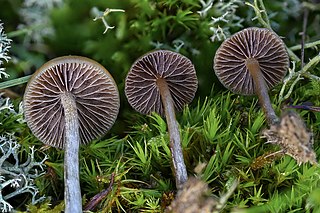
Psilocybe liniformans is a mushroom in the family Hymenogastraceae. It is in the section Semilanceatae of Psilocybe.

Psilocybe allenii is a species of agaric fungus in the family Hymenogastraceae. Described as new to science in 2012, it is named after John W. Allen, who provided the type collection. It is found in the northwestern North America from British Columbia, Canada to Los Angeles, California, most commonly within 10 miles (16 km) of the Pacific coast.
Psilocybe germanica is an invalidly described species of psychedelic mushroom in the family Hymenogastraceae. It was described as a new species in 2015 by Jochen Gartz and Georg Wiedemann. DNA sequencing of the balls of P. germanica has found that it is a synonym of P. serbica.
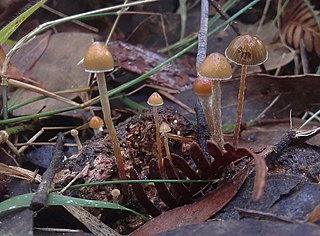
Psilocybe alutacea is a species of agaric fungus in the family Hymenogastraceae. It was described in 2006 and is known from Australia and New Zealand. It is coprophilous, growing on animal dung. The fruitbodies have a small conical or convex cap, subdistant gills with an adnate attachment, a slender brown stipe and a faint blueing reaction to damage. As a blueing member of the genus Psilocybe it contains the psychoactive compounds psilocin and psilocybin.

























